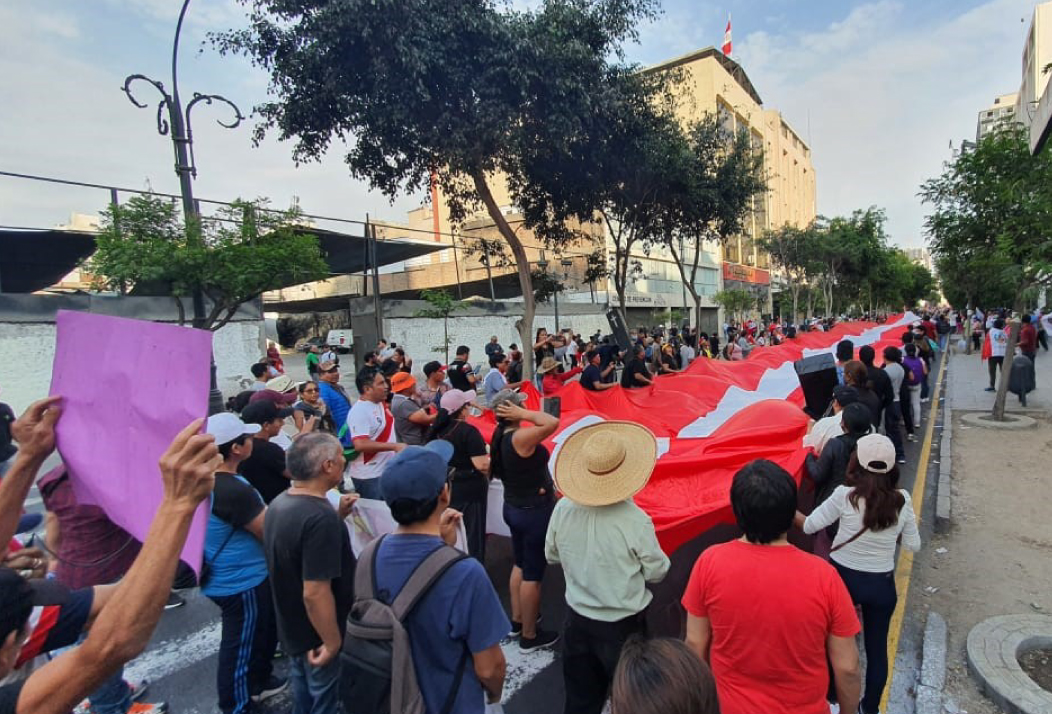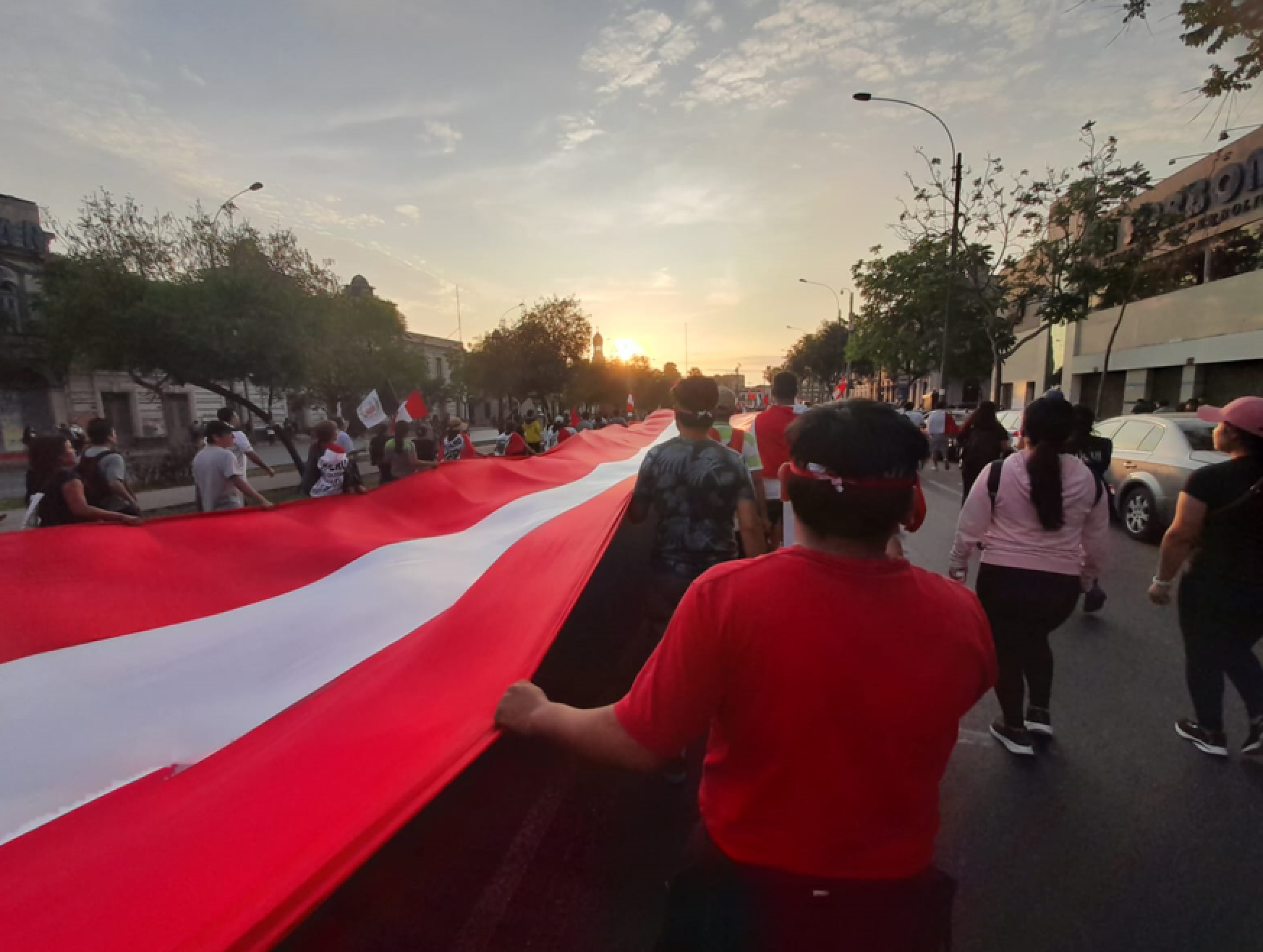The socio-political crisis the country is going through is systematic and structural. With this new wave of repression and racism, the way in which Indigenous peoples and peasants who live in the South of the country got organized should be highlighted. Treated by the State as second-class citizens, the Aymara, Chanca, Quechua, Ashaninka, and Awajun peoples are suffering and resisting institutional violence. If elections are not moved forwards and a Constituent Assembly is not formed, the Peruvian people will continue taking to the streets.
The socio-political crisis the country is going through is systematic and structural. With this new wave of repression and racism, the way in which Indigenous peoples and peasants who live in the South of the country got organized should be highlighted. Treated by the State as second-class citizens, the Aymara, Chanca, Quechua, Ashaninka, and Awajun peoples are suffering and resisting institutional violence. If elections are not moved forwards and a Constituent Assembly is not formed, the Peruvian people will continue taking to the streets.
“We have arrived to the great village of men and we are
stirring it. We reach it with our hearts, we penetrate it; with our
unextinguished joy, with the flashing delight of a suffering
man who has the power of the heavens, with our
old and new anthems, we are enshrouding it”.
“To Our Father Creator Túpac Amaru” – José María Arguedas
“We have arrived to the great village of men and we are stirring it. We reach it with our hearts, we penetrate it; with our unextinguished joy, with the flashing delight of a suffering man who has the power of the heavens, with our old and new anthems, we are enshrouding it”.
“To Our Father Creator Túpac Amaru” – José María Arguedas
Almost two months after the ousting of former President, Pedro Castillo, who attempted a coup while delivering a message to the country, protests and demonstrations have not stopped in Peru. To the contrary, they got worse due to the presence of the police and the Armed Forces as ordered by the current president, Dina Boluarte, and her Prime Minister, Alberto Otarola. They have been using firearms to repress the protests for weeks, and the number of murdered, wounded and detained people is well beyond the realm of imagination.
According to the Ombudsman Office, to date, 56 people have died: 46 civilians died during the confrontations, most of them suffered bullet wounds; nine civilians died due to traffic accidents and blocked roads; and a police officer died because of violent acts during the conflict. There are 979 wounded people according to the Ministry of Health and 580 officers as reported by the Peruvian National Police.

Fifty-six people were killed during police repression and there are thousands of wounded people. Photo: Jaime Borda

Fifty-six people were killed during police repression and there are thousands of wounded people. Photo: Jaime Borda
Events, actors and systematic abuse of human rights
Most of these murders, which are serious violations of human rights, have occurred in the Andean regions of Southern Peru, such as Ayacucho, Apurímac, Cusco and Puno. In the Puno region, 19 people have died, most of them young and under-aged, after suffering bullet wounds fired by the police.
Since Southern Peru has the highest number of rural and peasant communities, the demonstrators are shopkeepers, small businesspeople, professionals, and university students with peasant parents. Therefore, the Aymara, Chanca, Quechua, Ashaninka, and Awajun peoples have suffered the most police repression following the Dina Boluarte’s civilian-military regime.
The last event that generated outrage in the capital city was the National Police violently raiding San Marcos University, where delegations from different regions of the country were taking shelter.
The last event that generated outrage in the capital city was the National Police violently raiding San Marcos University.
Additionally, the government has declared a “state of emergency” in the whole country for several weeks and has also established an exceptional regime in regions where large demonstrations were taking place, restricting many rights. This allowed the detention of numerous leaders and heads of protests. Meanwhile, in Lima, the police have entered the building that belongs to the historical Peasants Confederation of Peru and have intimidated those who are in stores where opposing political parties meet.
What generated outrage in the capital city was the National Police violently raiding San Marcos University, a renown public university in Peru, where delegations from different regions of the country were taking shelter. More than 200 people were arbitrarily detained and suffered humiliating treatment. After two days, they were released thanks to the support of the National Coordinator of Human Rights as well as volunteer lawyers.

Thousands of people pour into Lima on a daily basis requesting Dina Boluarte’s resignation and a new call for elections. Photo: Jaime Borda

Thousands of people pour into Lima on a daily basis requesting Dina Boluarte’s resignation and a new call for elections. Photo: Jaime Borda
A political crisis that became a massacre
In 2021, Peru commemorated 200 years of republican life, and many Peruvians thought that it was possible to hope for a better future, that it was possible to make major changes that would solve old structural problems, such as social inequality, access to the justice system, exclusion and discrimination against Indigenous peoples.
This possible change was embodied by a person who, not so long ago, was the President of Peru, Pedro Castillo Terrones, a peasant professor and rondero (member of a self- governing peasant patrol) from Cajamarca who won the elections holding a narrow lead over his rival Keiko Sofia Fujimori, daughter of former dictator Alberto Fujimori. Today, former president Castillo is detained in Barbadillo prison in Lima after attempting a coup on December 7, 2022.
Unfortunately, Peru’s first female President decided to use repression against the demonstrators, creating an alliance with the Congress, the Armed Forces, the National Police and the District Attorney’s Office.
The President decided to use repression, creating an alliance with the Congress, the Armed Forces, the National Police and the District Attorney’s Office.
It is also true that the so called “self-ousting” of the former President was the result of a systematic campaign by the groups and parties that lost the 2021 elections. Since Pedro Castillo took office, they started talking about fraud so as not to acknowledge the results.
They had already tried to oust Castillo twice before. Unfortunately, there were enough reasons to question the former president. He was not surrounded by the right people, he chose his consultants and ministers poorly, and he had several corruption accusations in less than a year and a half of serving as such.

After close to a month of repression, the people are not afraid anymore and have decided to take to the streets until Dina Boluarte resigns. Photo: Jaime Borda

After close to a month of repression, the people are not afraid anymore and have decided to take to the streets until Dina Boluarte resigns. Photo: Jaime Borda
Tips to understand the crisis
For some, this is not just a political and social crisis, but a result of a systemic and structural crisis that occurred because the economic model applied in Peru has not worked. To the contrary, it has deepened inequality and widened the social gap. At the end of the day, we are still a primary exporting country that depends on its natural resources.
Anthropologist José Carlos Agüero believes we are facing a social collapse and an institutional collapse: “It is a decomposition process. The institutions do not represent what they used to for citizens; they have lost credibility and legitimacy: how legitimate is the Executive Branch, or the Legislative Branch, or the Judicial Branch, or any other institution at a subnational level? Not only is it extremely difficult to achieve minimum levels of governance when this happens, but it is also challenging for the different social classes to coexist. By all accounts, we are experiencing a rejection moment.”
Lima is filled with people from Puno, Juliaca and Ilave who are demanding respect and dignity for those Quechua and Aymara individuals who were murdered.
Lima is filled with people from Puno, Juliaca and Ilave who are demanding respect and dignity for those Quechua and Aymara individuals who were murdered.
In this sense, a relevant aspect to be considered in this crisis is the overwhelming participation of rural communities and villages in the demonstrations. Mostly peasant workers and Indigenous Peoples from Southern Peru. One of those regions is Puno, which is near Peru's border with Bolivia and has the largest Indigenous community in the country, specially Quechua and Aymara peoples.
Since Dina Boluarte took power, several Southern cities have been affected by repression and police brutality, particularly, Juliaca where more than 19 people were reported to have been murdered. Despite this sad figure, Lima is filled with people from Puno, Juliaca and Ilave who are demanding respect and dignity for those Quechua and Aymara brothers who were murdered. The demonstrators will not stop until Boluarte resigns, elections are moved forward to 2023, and a Constituent Assembly is formed.

Peasant workers and Indigenous Peoples from Southern Peru are leading the protests. Photo: Jaime Borda

Peasant workers and Indigenous Peoples from Southern Peru are leading the protests. Photo: Jaime Borda
History keeps repeating itself
Despite the crisis, the positive aspect is that the social fabric is starting to get mended. This is happening mainly in large and medium-sized cities. They are beginning to take action. Peasant communities and Amazonian peoples are also taking action and they have always kept an autonomous organization. During the period of political violence in Peru (1980 – 2000), these communities were the ones that resisted the terrorist attacks carried out by the Sendero Luminoso group and by State agents.
The affected regions back then were Ayacucho, Apurímac, Cusco and Puno, the exact regions that are being violently attacked today. The final report submitted 20 years ago by the Truth and Reconciliation Commission (TRC) in Peru had warned that history would repeat itself if the structural causes of political violence, such as poverty, exclusion, inequality and racism, were not dealt with. This is the feeling among the protesters: nothing has changed for Indigenous Peoples and communities.
For the time being, the political solution to this crisis lies in the hands of the National Congress and President Dina Boluarte. In the meantime, the only answers given by them are repression, violence, systematic abuse of human rights, stigmatization, criminalization and terruqueo against protesters. Unfortunately, old wounds have been reopened and they will be very difficult to heal, particularly, for the rural and peasant community.
Now, the rebellion of the Andean peoples who are demanding more respect and rights can be felt in Lima, a very conservative, classist, racist and colonial city.
